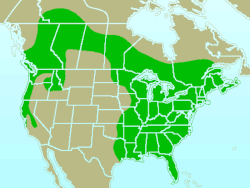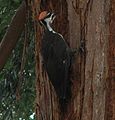Pileated woodpecker: Difference between revisions
Units/dates/other |
|||
| Line 39: | Line 39: | ||
* Pileated Woodpeckers make such large holes in dead trees that sometimes the holes can cause a small tree to break in half.<br/> |
* Pileated Woodpeckers make such large holes in dead trees that sometimes the holes can cause a small tree to break in half.<br/> |
||
* Pileated Woodpeckers have been observed to move their eggs which have fallen off the nest to another site. This is a rare habit in other birds. |
* Pileated Woodpeckers have been observed to move their eggs which have fallen off the nest to another site. This is a rare habit in other birds. |
||
*their tongues are 10 inches long! |
|||
<br clear="all"/> |
<br clear="all"/> |
||
Revision as of 23:57, 28 January 2009
| Pileated Woodpecker | |
|---|---|

| |
| male | |
| Scientific classification | |
| Kingdom: | |
| Phylum: | |
| Class: | |
| Order: | |
| Family: | |
| Genus: | |
| Species: | D. pileatus
|
| Binomial name | |
| Dryocopus pileatus (Linnaeus, 1758)
| |

| |
The Pileated Woodpecker (Dryocopus pileatus) is a very large North American woodpecker.
Adults (40-49 cm long, 250-350 g weight) are mainly black with a red crest and a white line down the sides of the throat. Adult males have a red line from the bill to the throat and red on the front of the crown. In adult females, these are black. They show white on the wings in flight. The only North American birds of similar plumage and size are the Ivory-billed Woodpecker of the Southeastern United States and Cuba, and the related Imperial Woodpecker of Mexico. Both of those species are extremely rare, if not extinct.

Their breeding habitat is forested areas with large trees across Canada, the eastern United States and parts of the Pacific coast. They usually excavate large nests in the cavities of dead trees, and often excavates a new home each year, creating habitat for other large cavity nesters.
This bird is usually a permanent resident.
These birds mainly eat insects (especially beetle larvae and carpenter ants) as well as fruits, berries and nuts. They often chip out large and roughly rectangular holes in trees while searching out insects.
The call is a wild laugh, similar to the Northern Flicker. Its drumming can be very loud, often sounding like someone striking a tree with a hammer. This bird favors mature forests, but has adapted to use second-growth stands and heavily wooded parks as well.
Miscellaneous facts

- The Pileated Woodpecker was the model for the cartoon character Woody Woodpecker.[1]
- The pileated woodpecker is also commonly known in the south as an "Indian Hen"
or "Rain crow" - The roost of a Pileated Woodpecker usually has multiple entrance holes.
- The sound that a Pileated Woodpecker makes when boring a hole in a tree is so loud that it can be heard over long distances.
- Pileated Woodpeckers make such large holes in dead trees that sometimes the holes can cause a small tree to break in half.
- Pileated Woodpeckers have been observed to move their eggs which have fallen off the nest to another site. This is a rare habit in other birds.
- their tongues are 10 inches long!
Photos
-
A male at a suet feeder
-
A male
-
A male on a platform feeder.
-
A male feeding a juvenile by regurgitation.
-
Juvenile female Woodpecker
-
Mature female
-
Male
-
Close up at end of ant infested log.
-
Close up on log
-
Mating pair
-
Pecking on a tree
Notes
- ^ Farwell, Harold F. (1993). Smoky Mountain Voices. University Press of Kentucky. p. 182. ISBN 9780813118239.
{{cite book}}: Unknown parameter|coauthors=ignored (|author=suggested) (help)
References
- Template:IUCN2006 Database entry includes justification for why this species is of least concern
- Interesting Pileated Woodpecker Facts donated by BirdHouses101.com
- Birdchat archives--lists "Lord God Bird" as folk name for this species
External links
- Pileated Woodpecker videos on the Internet Bird Collection
- Stamps












